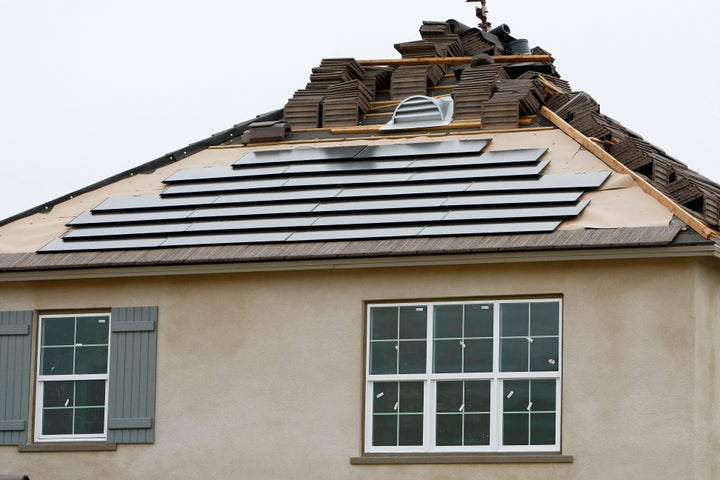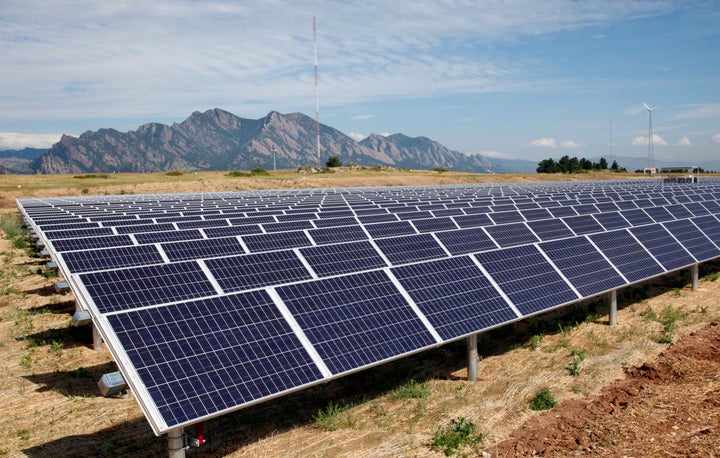
Shout it from the rooftops -- America's rooftop solar capacity could be double what scientists previously thought.
If Americans slapped solar panels on every flat, sunny rooftop in the country, the U.S. could satisfy nearly 40 percent of its total electricity demand from solar alone, according to a new study from the National Renewable Energy Laboratory.
Experts say the numbers reflect newer, better methods for calculating total solar potential.
"For figuring out technical solar potential, I think this is a very good study," Mike Jacobs, senior energy analyst at the Union of Concerned Scientists, told The Huffington Post.
Researchers used sophisticated LiDAR technology to map the topography of 128 cities in the U.S. down to the square meter. Combining that data with estimates of solar capacity researchers were able to gauge the total rooftop space available for solar power production in the U.S.
Their findings estimate the "technical potential" of rooftop solar production in the U.S. to be 1,118 gigawatts of capacity, which amount to 39 percent of national electricity sales and is nearly double what previous studies estimated. The study also found that small buildings hold the greatest solar potential, accounting for 65 percent of potential rooftop solar capacity.
That doesn't mean the U.S. will start generating nearly half of its electricity from rooftop solar panels, however. "Technical potential" refers only to what the U.S. could produce if every inch of suitable rooftop space were used for solar production, said Robert Margolis, senior energy analyst at NREL and co-author of the study. "It’s not necessarily what you would do economically," Margolis told HuffPost.
Researchers counted only rooftops that receive enough sunlight to power solar panels efficiently. Rooftops blocked from the sun by trees or other obstructions, as well as north-facing rooftops, were ruled out. The study also didn't count solar installations in parking lots or large-scale industrial facilities.

The Obama administration's Clean Power Plan is aiming for a 30 percent reduction of total carbon emissions in the U.S. by 2030. The expansion of solar and other renewable energies will be key to meeting that goal. Accurately assessing the country's rooftop solar potential could help researchers and lawmakers figure out how to blend rooftop solar into a cleaner national energy mix, according to Margolis.
"It's a fundamental input to understanding what role rooftop solar could play in our energy system," Margolis said.
The numbers could also help shore up the case for expanding the use of rooftop solar. Putting solar panels on rooftops produces electricity close to where people consume it, but it tends to be less efficient and more expensive than producing electricity at large-scale solar facilities, according to Jacobs. The NREL's new estimates for rooftop solar capacity could make small-scale solar operations look like a more viable option to investors.
"There's been a lot of debate about whether large-scale solar is a solution versus rooftop solar, Margolis said. "There's a lot of technical potential for rooftops and for large-scale solar -- both have roles to play."
The study's findings are particularly good news for renewable energy advocates, who say switching to solar and other alternative energy sources is necessary to reduce the world's reliance on fuels that release climate-warming carbon emissions.
Currently, solar makes up 0.4 percent of total electricity production in the U.S. But investment in renewable energy is soaring. The cost of solar production has plummeted in recent decades, and since 2010, the number of solar installations worldwide has doubled seven times, according to Bloomberg. At the same time, the number of active oil rigs has fallen precipitously, and several major coal companies have closed their doors in recent months.
For Margolis, meeting future energy needs will require developing a range of new energy sources.
"We need a mix of technologies," he said. "There’s not a single solution."
